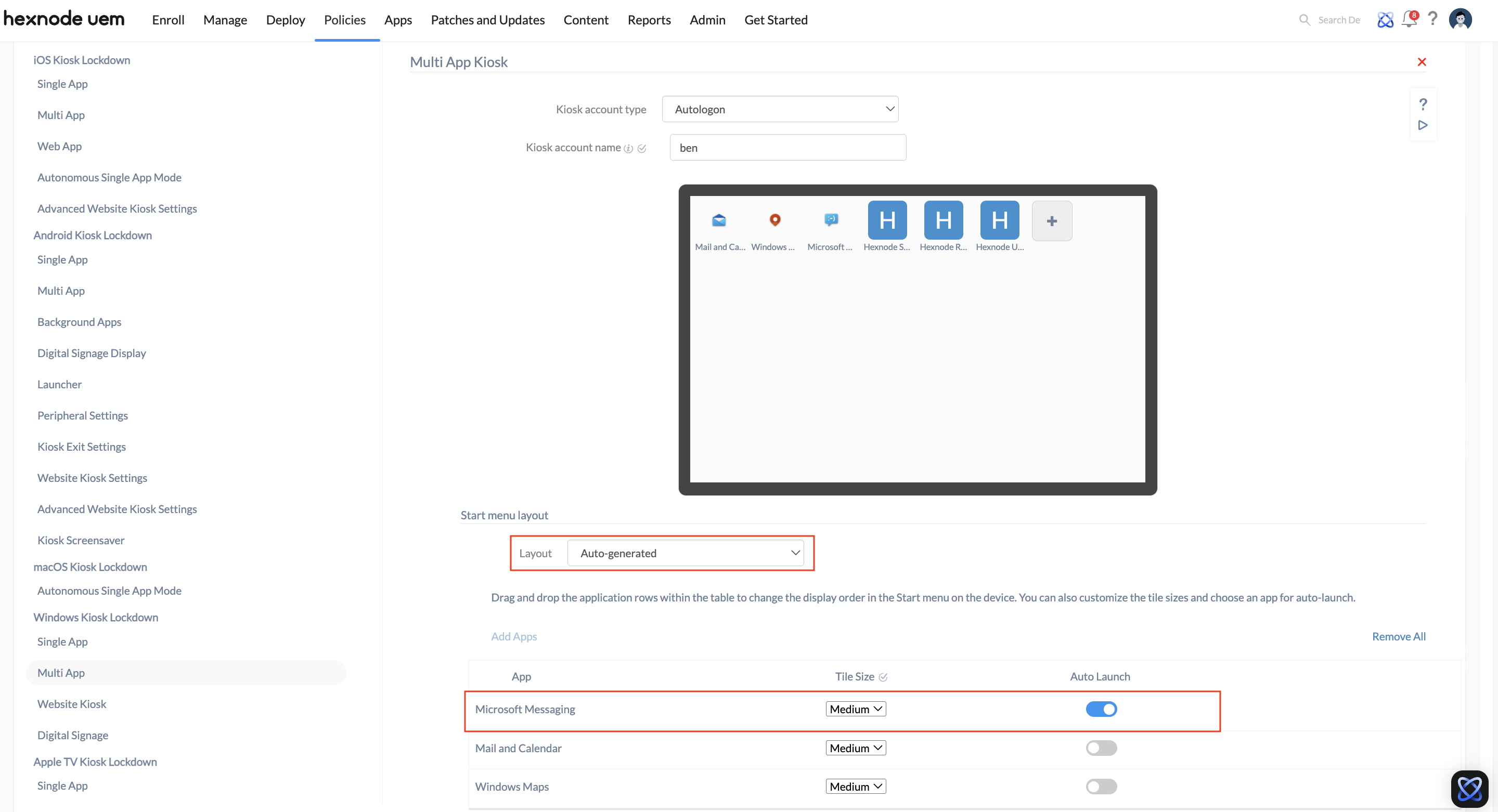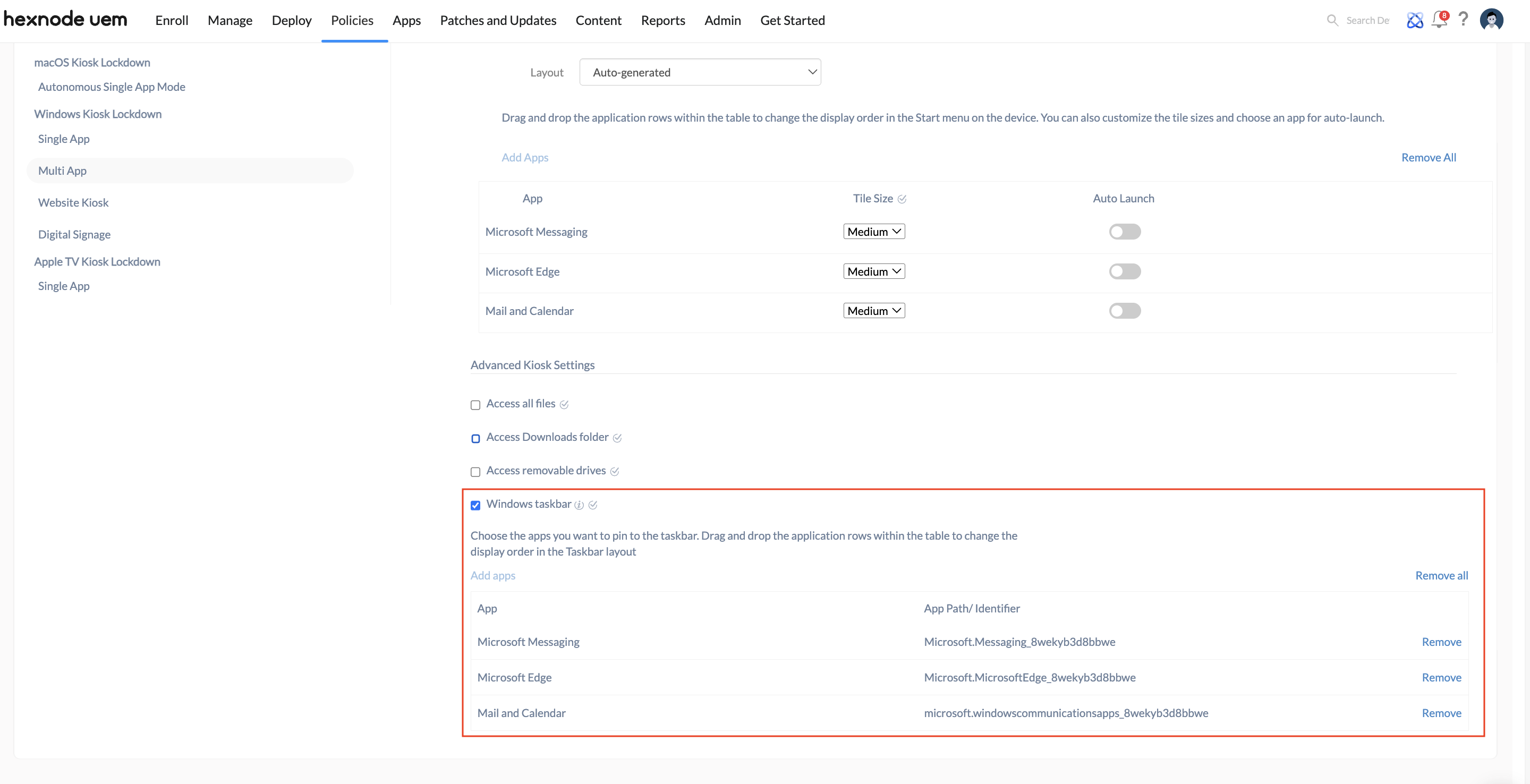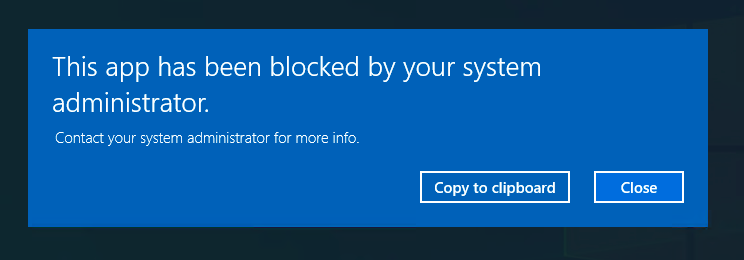Category filter
How to lock down Windows devices in Multi App kiosk mode?
Kiosk mode is a lockdown mechanism that allows you to restrict your devices to a single app or a few applications of your choice. Multi App kiosk mode locks your device to a handful of allowlisted applications, thus preventing the users from accessing any other features on the device. Restricting the device to a few apps reduces user distractions and provides users with only the things that they need to access.
Configure Multi App kiosk
Before associating the policy, you must create a local user account on your device and install the Universal Windows Platform (UWP) apps that you want to run in kiosk mode.
To create a local user account on Windows 10 Pro version:
- Click on the Start button.
- Navigate to Settings > Accounts > Family & other users.
- Select the option Add someone else to this PC under Other users.
- Click on the link I don’t have this person’s sign-in information.
- Select the option Add a user without a Microsoft account.
- Fill in the kiosk user’s name, password, and other required fields.
To create a local user account on Windows 10 Enterprise and Education versions:
- Click on the Start button.
- Navigate to Settings > Accounts > Other people. On some Windows editions the option would be named as Other users.
- Select the option Add someone else to this PC.
- In the inset box, select Users.
- Under Actions, select Users > More actions > New User.
- Fill in the kiosk user’s name, password, and other required fields.
To create a local user account on Windows 11 Pro version:
- Click on the Start button.
- Navigate to Settings > Accounts > Other users.
- Select the option Add account.
- In the inset box, select Users.
- Under Actions, select Users > More actions > New User.
- Fill in the kiosk user’s name, password, and other required fields.
Now, the user account will be set up on the device.
After setting up the account, make sure the apps to be set in kiosk mode are installed on both the admin and local user accounts.
- Log in to your Hexnode UEM portal and navigate to the Policies tab.
- Click on New Policy to create a new one or click on any policy name to edit an existing one. If you are creating a new policy enter the Policy Name and Description in the provided fields.
- Go to Kiosk Lockdown > Windows Kiosk Lockdown, select Multi App > Configure.
- Enter the name of the user account you want to run in multi app kiosk mode in the Kiosk Account Name field.
Choose from the following kiosk account types:
- Local user: Enter the name of a local user account.
- AD user: Enter the Active Directory user account name.
- Microsoft Entra ID user: Enter the user’s Microsoft Entra ID email address.
If you are using the Microsoft account to enable sign in to the kiosk, you can specify the account name in either of the following formats:
- For an AD user – domain\samAccountName.
- For a Microsoft Entra ID user – email address.
- Autologon (supported on Windows 10 version 1809 and later, and Windows 11): This option lets you specify a name for the kiosk account. A local standard user account with the chosen name is created on the device and automatically signed into the kiosk after the device restarts.
- Click on the + button to select the app to be added in kiosk mode. You can add local apps, public store apps and desktop apps to the kiosk.
- Select your preferred Start menu layout:
Custom Start menu layout
Customizing a Start layout involves arranging the apps (to be set in kiosk mode) in a way the user wants to view them on the Start menu and on the device screen. Login to the admin account on the device and follow the steps below to prepare and export the Start layout manually.
- The following steps allow you to customize the Start layout from the device.
- Pin apps to Start: Choose the desired app from Start by typing in the app name. Right-click the app and click Pin to Start.
- Apps that are not to be displayed in the layout can be unpinned. Right-click the app and then click Unpin from Start.
- Drag tiles to group apps.
- Right-click Start > select Windows PowerShell.
- Execute the below command in Windows PowerShell:
- If the device is running Windows 10 version 1607, 1703, or 1803:
1Export-StartLayout –path <file path><file name>.xml
- For example,
Export-StartLayout -path C:\Users\Robert\Kiosk.xml
- For example,
- If the device is running Windows 10 version 1809 or above:
1Export-StartLayout -UseDesktopApplicationID –path <file path><file name>.xml
- For example,
Export-StartLayout -UseDesktopApplicationID -path C:\Users\Robert\Kiosk.xml
- For example,
- If the device is running Windows 11:
1Export-StartLayout –path <file path><file name>.json
- For example,
Export-StartLayout -path C:\Users\Robert\Kiosk.json
- For example,
- If the device is running Windows 10 version 1607, 1703, or 1803:
- Go to the Start menu layout section of your multi-app kiosk policy.
- Select Auto-generated as the layout type.
- Click Add Apps to import applications from those already configured in the multi-app kiosk policy. Only these apps can be selected for inclusion in the Start menu layout.
- Drag and drop app rows to set apps' display order in the Start menu.
- Select a tile size for each app: Small, Medium, Wide, or Large. (For desktop apps, only Small and Medium sizes are available).
- Choose an app to Auto-launch after the kiosk user logs in (optional). The app set to auto-launch will automatically open right after the user logs into the multi-app kiosk account on the Windows device.
Here, –path is a required parameter that specifies the path and file name of the XML or JSON file to be exported on the device.
Auto-generated Start menu layout
Hexnode allows you to automatically generate the Start menu layout based on the apps included in your multi-app kiosk policy. To set this up:
- The following steps allow you to customize the Start layout from the device.
- Under Advanced Kiosk Settings, configure additional options as needed:
- Access all files (Supported on Windows 10(v1809+) devices): Enabling this option provides access to the entire File Explorer while the device is in multi-app kiosk mode.
- Access Downloads folder (Supported on Windows 10(v1809+) devices): Enabling this option allows access exclusively to the Downloads folder in File Explorer during multi-app kiosk mode.
- Access removable drives (Supported on Windows 10(v1809+) devices): If this option is left unchecked, users will be restricted from accessing removable drives through File Explorer while the device is in multi-app kiosk mode.
- Windows taskbar (Supported on Windows 10(v1809+) and Windows 11 devices): Enabling this option allows the taskbar to appear in multi-app kiosk mode on devices. By clicking Add Apps, you can import apps already included in the multi-app kiosk configuration into the taskbar layout. Only these apps are eligible for taskbar inclusion. Once the apps are added, you can arrange them by dragging and dropping the rows in the app list, giving you control over the order in which the apps are displayed on the device's taskbar. Note that pinning apps to the taskbar and configuring their order is only supported on Windows 11 devices.
On devices running Windows 11 24H2, disabling the taskbar via the Windows taskbar setting does not hide it completely. Instead, it hides until the user interacts with it using the mouse.
- Save the policy.
How to add desktop apps to kiosk?
Other than local apps and public store apps, Hexnode even allows you to add desktop apps to the kiosk. While customizing a Start layout, only pin the desktop apps that the user needs to see in the Start Menu. The desktop apps not added to the Start Menu will run in the background whenever necessary, provided you add them to the kiosk. To add desktop apps to the kiosk:
- Click on Policies > New Policy to create a new one or click on any policy name to edit an existing one. If you are creating a new policy enter the Policy Name and Description in the provided fields.
- Go to Kiosk Lockdown > Windows Kiosk Lockdown, select Multi App > Configure.
- Enter the Kiosk account name.
- Click on the + button and select Desktop Apps. Click on the Add button after providing the app name and the location of the app on the device. For example, to add Hexnode UEM app as a kiosk application, enter HexnodeUEM.exe and C:\Hexnode\Hexnode Agent\Current\HexnodeUEM.exe as the App name and Path respectively.
- Import/auto-generate the Start menu layout containing the apps that need to be present in the Start menu.
- Save the policy.
How to associate the policy with devices/groups?
There are two ways by which you can assign restrictions to the devices in bulk.
If you haven’t saved the policy yet,
- Navigate to Policy Targets.
- Click on + Add Devices, search and select the required devices to which you need to apply the policy and click OK.
- Click on Save to apply the policies to the devices.
To associate the policies with a device group, select Device Groups from the left pane under Policy Targets, and follow the above instructions. Similarly, you can associate the policy with Users, User Groups, or Domains from the same pane.
If you’ve already saved the policy and you’re taken to the page which displays the policy list,
- Select the required policy, click on Manage and select Associate Targets.
- Select Device/ User/ Device Group/ User Group/ Domain.
- Search and select the devices/ users/ device groups/ user groups/ domains to which you need to apply the policy and click Associate.
What happens at the device end?
Restart the device after applying the policy for it to take effect. When a user logs into their local user account, the apps added in the kiosk mode will be displayed on the start screen. The user will be unable to access the settings or other apps on the device.
Secondary displays on Windows kiosks
While in the kiosk lockdown mode, a Windows device can be connected to secondary displays.
How to exit kiosk mode?
You can exit devices from kiosk mode either by disassociating or archiving the policy. Besides, you also need to restart the device to remove it from kiosk mode.
Method 1: Disassociate the policy
Disassociate the kiosk policy from the device or delete the policy and restart the device.
- Log in to your Hexnode UEM portal.
- Navigate to the Policies tab.
- Click on the required policy name and go to Policy Targets. Click on the Remove option corresponding to the device.
- Log in to your Hexnode UEM portal.
- Navigate to the Manage tab.
- Click on the required device and go to Policies. Click on the trash icon corresponding to the kiosk policy.
Method 2: Archive the policy
- Log in to your Hexnode UEM portal.
- Navigate to the Policies tab.
- Select the required Policy, click on Manage > Move to Archive.
Method 3
If the methods mentioned above fail to remove the kiosk policy from the device, press CTRL+ALT+DEL. This locks the screen and allows users to sign in with a different account from the login page. However, the previous user account remains in kiosk mode, and once the user logs in to the account, the kiosk mode gets relaunched.







